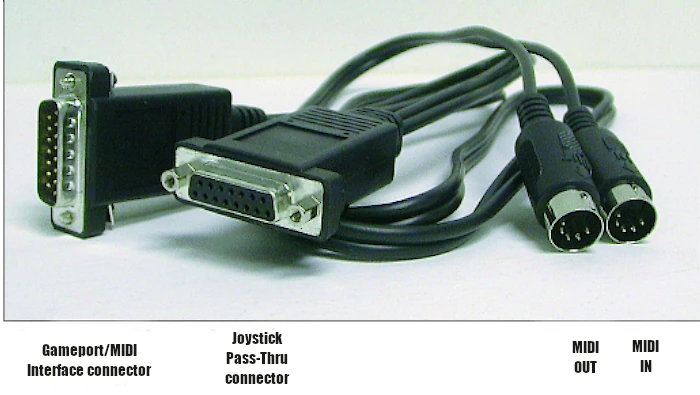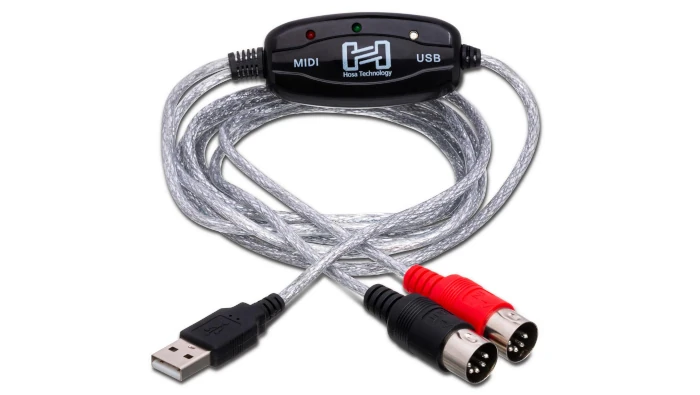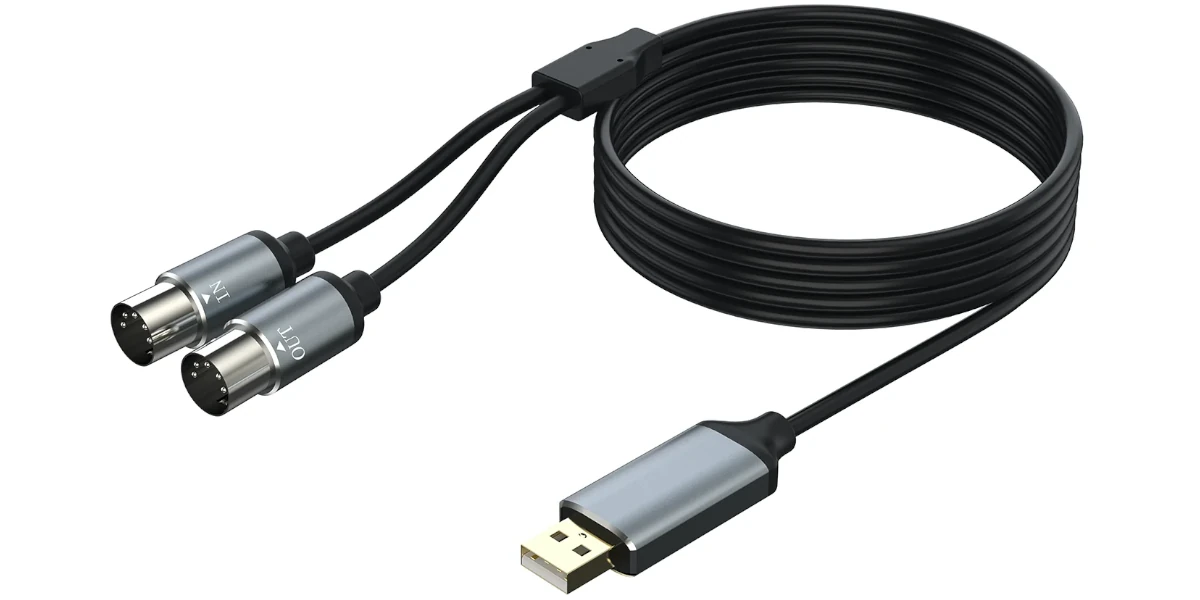Greetings, music mavens and gadget gurus! Ready to elevate your home studio game with a tool that might just seem unassuming at first glance? Yes, I’m talking about the USB MIDI cable – a slender bridge connecting the expressive world of music with the boundless potential of digital technology. Whether you’re crafting beats on your computer or integrating traditional instruments into your arrangements, the USB MIDI cable is a key player in the symphony of your creative workflow.
In the digital age, the art of music production has transformed dramatically. Gone are the days of needing bulky, expensive equipment to produce high-quality music. Today, a home studio, no matter how modest, can churn out tracks that rival professional studios. At the heart of this revolution lies the humble USB MIDI cable, a conduit of creativity that seamlessly links musical instruments to computer software.
The magic of the USB MIDI cable lies in its ability to translate the analog signals from your keyboard, drum pad, or other MIDI-compatible instruments into digital data that your computer understands. This data can then control software instruments within your digital audio workstation (DAW), effectively turning your computer into an orchestra, synthesizer, and recording studio all in one.
Exploring the Versatility of USB MIDI Cables
But it’s not just about playing notes on a software instrument. With a USB MIDI cable, you can manipulate a myriad of parameters within your DAW, from adjusting tempos and tweaking synth parameters to controlling playback and recording. This two-way street allows for an interactive experience where the software’s capabilities inspire you just as much as you control them.
Moreover, leveraging the power of MIDI through a USB cable means you can save, edit, and perfect your performances. Imagine playing a keyboard part, then going back to adjust the timing or dynamics without having to re-record the whole piece. This level of control is what makes digital music production so thrilling and forgiving for artists.
But let’s not overlook the technical harmony achieved through USB connectivity. Most modern computers and laptops offer USB ports, making the connection hassle-free and universally accessible. The plug-and-play nature of most USB MIDI cables means you can spend less time troubleshooting and more time creating.
As we delve deeper, remember that the right knowledge and tools, like the USB MIDI cable, can turn the complex orchestra of music production into a harmonious and intuitive extension of your artistic vision. So, let’s turn up the volume on our understanding and discover how this essential cable can be the unsung hero of your home studio setup. Stay tuned, and let’s unravel the melody of possibilities together.
1. A Brief History of the USB MIDI Cable

Let’s step back in time and uncover the roots of a pivotal piece of technology in the music world: the USB MIDI cable. Since the digital dawn of the 1980s, this seemingly modest cable has been the unsung hero, connecting computer keyboards and facilitating the birth of electronic music as we know it.
Initially, the MIDI (Musical Instrument Digital Interface) protocol was designed to allow electronic musical instruments, computers, and other related devices to communicate, control, and synchronize with each other. It was a revelation, enabling musicians to create layered compositions with multiple synthesizers long before the digital audio workstation (DAW) became ubiquitous.
In this pre-USB era, MIDI cables typically used a DB25 connection, connecting to the MIDI/GAME port on sound cards of the time. It wasn’t uncommon for electronics enthusiasts to craft their own MIDI cables, a testament to the hands-on, DIY spirit that permeated the early days of electronic music production.
The Evolution of USB MIDI Cables
As technology marched forward, the Universal Serial Bus (USB) emerged in the mid-90s, heralding a new era in data transfer and device interconnectivity. The USB’s introduction marked a significant leap forward, offering a standardized, user-friendly solution for connecting a myriad of devices—including musical instruments.
The first USB MIDI cables were somewhat clunky, consisting of a box that bridged the USB plug with MIDI connectors. Nevertheless, this innovation bridged the gap between traditional electronic music instruments and the burgeoning world of computer-based production. Over time, these cables evolved into more streamlined, continuous designs, enhancing aesthetic appeal and functional convenience.
Today’s USB MIDI cables are sleek, efficient, and integral to the modern music production landscape. They represent the culmination of decades of development, encapsulating the journey from analog beginnings to digital dominance. As we explore the nuanced capabilities of these cables, it’s essential to remember the rich history behind them. This legacy continues to inspire and facilitate the creativity of musicians and producers around the globe.
2. The Versatile Usage of USB MIDI Cables Today

Long gone are the days when USB MIDI cables were solely the domain of music production puritans. Today, these cables weave through the fabric of our musical experiences in more ways than one might imagine. Let’s explore how these nimble connectors have broadened their horizons, becoming ubiquitous in both amateur and professional setups.
A Gamer’s Unexpected Ally
Interestingly, the reach of USB MIDI cables has extended into the gaming world. Remember Guitar Hero? Yes, the same game that turned living rooms into concert stages! USB MIDI cables are the unsung heroes behind the scenes, connecting those plastic guitars to gaming consoles and PCs, thus brididing digital entertainment and music production.
In the Heart of Home Studios
The versatility of USB MIDI cables truly shines in home studios. These cables are the lifelines that connect MIDI keyboards, drum pads, and other controllers to computers, allowing enthusiasts and professionals alike to compose, mix, and master their creations with precision. Software like Sonar, FL Studio, and Ableton Live rely heavily on MIDI inputs for music production, making USB MIDI cables indispensable for modern music creators.
A Network of Musical Instruments
Beyond PCs and gaming consoles, USB MIDI cables serve as the backbone for creating a symphony of interconnected instruments. Imagine a setup where synthesizers, drum machines, and sequencers communicate seamlessly, sharing MIDI data to create complex, layered soundscapes. This interconnectedness exemplifies the cables’ ability to foster collaboration among different devices, bringing to life compositions that were once only imaginable.
Education and Learning
In the realm of music education, these cables also play a pivotal role. Connecting a MIDI keyboard to educational software allows students to practice with interactive lessons, receive instant feedback, and accelerate their learning process. This application underscores the utility of USB MIDI cables in making music education more accessible and engaging.
Live Performances
Beyond the confines of studios, USB MIDI cables find their place on stage. Musicians and DJs harness the power of these cables to integrate laptops, samplers, and MIDI controllers into their live setups. This integration enables on-the-fly adjustments and triggers complex audio sequences, allowing artists to deliver mesmerizing performances.
The versatility of USB MIDI cables today transcends traditional boundaries, embedding themselves into various facets of music creation, entertainment, and education. They symbolize the intersection of music and technology, empowering artists, gamers, and learners to explore new realms of creativity. As we continue to uncover the potential of these handy cables, one thing remains clear: the possibilities are as limitless as our imagination.
3. Choosing the Right USB MIDI Cable for You
Selecting an ideal USB MIDI cable for your home studio setup or live rig might seem like a tiny step, but it’s akin to choosing the perfect guitar pick for your strumming style – it can significantly affect your performance and satisfaction. With an array of options available, how do you ensure you’re picking a winner? Let’s break it down.
Look Beyond the Price Tag
It’s tempting to go for the most affordable option, especially when you’re on a budget. However, like many things in life, with USB MIDI cables, you often get what you pay for. Extremely cheap cables might work in a pinch but can be prone to latency issues, poor build quality, and shorter lifespans. That said, it doesn’t mean you need to splurge on the most expensive option. Aim for a balanced choice, where both quality and price meet your needs.
Consider the Country of Origin
Though it might not be the first factor that comes to mind, the country of origin can be a good quality indicator. Some countries are renowned for their meticulous attention to electronics manufacturing quality, while others might prioritize cost-saving measures over durability. Researching brands and reading reviews can provide insights into which manufacturers are reliable.
Compatibility and Connectivity
Before adding a USB MIDI cable to your cart, double-check compatibility with your current gear. Ensure the cable supports the operating system you’re using (Windows, macOS, Linux) and is compatible with the specific model of your instruments or MIDI devices. Also, consider the type of USB connection your computer supports and whether you need a traditional 5-pin MIDI connection or a different configuration.
Durability Matters
The life of a USB MIDI cable can be tough, constantly being plugged in and out, twisted, or even stepped on. Look for cables with robust construction, thick insulation, and reinforced connectors. These features can safeguard your cable from the common perils of studio and stage life, ensuring a longer-lasting reliable connection.
Latency: The Time-Sensitive Issue
Latency refers to the delay between striking a key and hearing the sound. Even slight latency can throw off a performance or recording session. While many factors affect latency, a quality USB MIDI cable designed for minimal transmission delay can mitigate these issues, ensuring a more responsive and enjoyable playing experience.
Personal Recommendation: IconnectMIDI Model 1
One USB MIDI cable I’ve found reliable for various applications is the IconnectMIDI model 1 from iConnectivity. This particular cable strikes a good balance between affordability and performance. It boasts a solid build quality, compatible with a wide range of devices and software, and offers minimal latency, making it a superb choice for both novice and seasoned music producers.
Choosing the right USB MIDI cable might require a bit of research and consideration, but it’s an investment in the quality and efficiency of your music production and performance. With the right cable, you can focus more on the music and less on troubleshooting connectivity issues. Happy producing!
4. Common Challenges and Solutions with USB MIDI Cables
Navigating through the world of music production is thrilling, yet, like any technological endeavor, it comes with its set of hurdles. USB MIDI cables, despite their utility, are no strangers to these obstacles. Here’s a breakdown of some common issues you might encounter, accompanied by handy solutions to keep the music flowing uninterrupted.
Striking a Chord With Mac Devices
It’s not uncommon to plug in a USB MIDI cable, only to find that your Mac isn’t recognizing it. Devices not appearing, missing ports, or unresponsive automap buttons can halt your creative process. The fix? Often, a simple driver update or a visit to the device manufacturer’s website for specific troubleshooting guidelines does the trick. Resources like “My USB MIDI Device Is not Working On My Mac” offer a wealth of information to get your gear in sync.
The Dilemma of Drivers
A seamless connection between your USB MIDI cable and computer sometimes hinges on the right driver. Yamaha USB-MIDI devices, as an example, have a dedicated USB-MIDI Driver Download Page to ensure compatibility. If you’re using a more niche cable like the Terrasoniq MIDI ONE, ensure you’re equipped with the correct drivers. For those employing generic cables, the Blindskunk Windows 7 Generic USB MIDI Cable driver is a lifesaver. Download Blindskunk Windows 7 Generic USB MIDI Cable (VIEWCON) Always prioritize official drivers from the manufacturer’s site to dodge potential issues.
Guitar Hero Drumset Sync-Up
Linking a Guitar Hero drumset to your PC for a jam session isn’t as straightforward as one might hope. However, with the right guide or tutorial, such as “Hack a Guitar Hero drumset to use it with any computer over USB, Part 1” the task becomes achievable. These resources can push your creativity to new heights, proving that solutions are out there—you just need to know where to look.
Casio Keyboard Connectivity
Owners of Casio keyboards might hit a snag when realizing their instrument doesn’t use the common USB Type B port. Fear not, as specific cables designed for these models are available. Moreover, tutorials like the one found on Cassio Music Academy demystify the process, guiding you through each step to ensure your keyboard and computer are in perfect harmony.
Garageband Compatibility
Lastly, if your USB MIDI cable seems to rebel against Garageband, don’t despair. This issue is often rectified by checking for software updates or re-scanning for MIDI devices within the app. Community forums and official Apple support can also provide bespoke advice tailored to your situation.
In Summary
While challenges with USB MIDI cables can momentarily disrupt your creative flow, they’re often surmountable with a little bit of knowledge and patience. Remember, the tech community is vast and supportive. Chances are, someone else has faced—and solved—the very issue that’s stumping you. Stay curious, connected, and creative, and you’ll find that these hurdles are just stepping stones to greater musical exploration.
5. Integrating USB MIDI Cables with Your Favorite Devices and Software
Now, let’s dive into the practical side of things – making your USB MIDI cable work in harmony with your beloved instruments and software. Whether you’re navigating the nostalgic keys of a Casio keyboard, setting the rhythm on a Guitar Hero drum set, or crafting your next masterpiece in GarageBand, seamless integration is key to a frictionless music production experience. Here are the essential tips and tutorials to get your devices and software in sync.
Unleashing the Rhythm with Guitar Hero Drum Sets
Did you know that the drum set from Guitar Hero can be more than just a gaming accessory? Yes, by connecting it to your PC via a USB MIDI cable, you open up a new world of musical possibilities. It’s a bit of a project, but the result is a unique, customizable controller for your digital audio workstation (DAW). Check out [this guide](https://example.com) for a step-by-step tutorial on how to bridge the gap between gaming and music production. It’s a challenging yet rewarding endeavor that pushes the limits of conventional music-making.
Connecting the Classic Casio Keyboard
Many Casio keyboards come MIDI-ready, but connecting them can sometimes be tricky, especially if they use a USB Type B port. Fear not, as this is where your trusty USB MIDI cable comes into play. For keyboards not directly supporting a USB Type B connection, a concise tutorial at the [Casio Music Academy](https://example.com) lays down the basic steps to connect your musical keyboard to your PC or MAC. Following this guidance will ensure that your keyboard becomes an integral part of your home studio setup in no time.
Making Music with GarageBand and USB MIDI Cables
GarageBand users often face a common dilemma: the dreaded “USB MIDI cable not working” scenario. If you find yourself in this boat, there’s no reason to panic. The key is to ensure that your cable and software are speaking the same language. Sometimes, a simple driver update or a check on the cable’s compatibility could clear up any issues. Dive deeper into solving these hitches with a handy guide USB MIDI cable not working in garageband, and get back to laying down those tracks without a hitch.
Tips for a Harmonious Setup
– Check Compatibility: Always verify that your USB MIDI cable is compatible with the device or software you’re using. Look for any specific requirements listed by the manufacturer.
– Driver Updates: Keep your drivers up to date. Whether it’s for your Yamaha keyboard or Terrasoniq MIDI ONE USB MIDI Cable Interface, updated drivers can solve a plethora of connectivity issues. Here’s the driver download for the Terrasoniq MIDI ONE USB MIDI Cable Interface
– Follow Tutorials: Especially for more complicated setups, like hacking a Guitar Hero drum set, following detailed tutorials can save you time and frustration.
Remember, the beauty of music production lies in experimentation. With your USB MIDI cable acting as the bridge between traditional instruments and modern software, the possibilities are endless. So go ahead, connect, play, and explore the vast horizons of your musical creativity.
6. Conclusion: Amplifying Your Music Production with USB MIDI Cables
As we’ve journeyed through the realm of USB MIDI cables, it’s clear that this seemingly modest tool wields the power to revolutionize home studios. From revisiting its origins in the 1980s to exploring its pivotal role in the modern music production ecosystem, we’ve unfurled the many layers of versatility and utility it offers. Whether you’re orchestrating elaborate musical arrangements, connecting iconic hardware, or dabbling in music creation software, the USB MIDI cable is your trusted conduit to realizing your artistic vision.
Navigating Selection and Integration
A key takeaway from our exploration is the critical importance of choosing the right USB MIDI cable. It’s not just about compatibility; it’s about ensuring your musical setup is primed for reliability and quality. Heeding the advice on selecting a reputable cable can save you from unnecessary hurdles, letting your creativity flow uninterrupted.
Moreover, we’ve navigated through common challenges and offered solutions to ensure that these technical glitches don’t hamper your creative process. It’s comforting to know that most issues have manageable fixes, ensuring your setup remains harmonious and productive.
Integration with devices and software revealed another layer of versatility. Whether hooking up a Casio keyboard, engaging with a Guitar Hero drum set, or optimizing Garageband, the adaptability of USB MIDI cables across platforms and gadgets is a testament to their indispensable role in music production.
Embracing the Future of Music Making
To encapsulate, USB MIDI cables are more than just connectors; they are bridges to greater musical exploration and expression. They encourage musicians to expand their horizons, experiment with new setups, and ultimately refine their sound. As technology continues to evolve, so too will the capabilities and applications of USB MIDI cables, promising even more exciting prospects for music creators worldwide.
So, let’s embrace the opportunities that USB MIDI cables offer. Dive into your home studio with renewed enthusiasm and let these dynamic tools amplify your musical journey. Remember, in the world of music production, your imagination is the only limit. Here’s to creating, experimenting, and discovering the endless possibilities that lie ahead. Happy music making!

